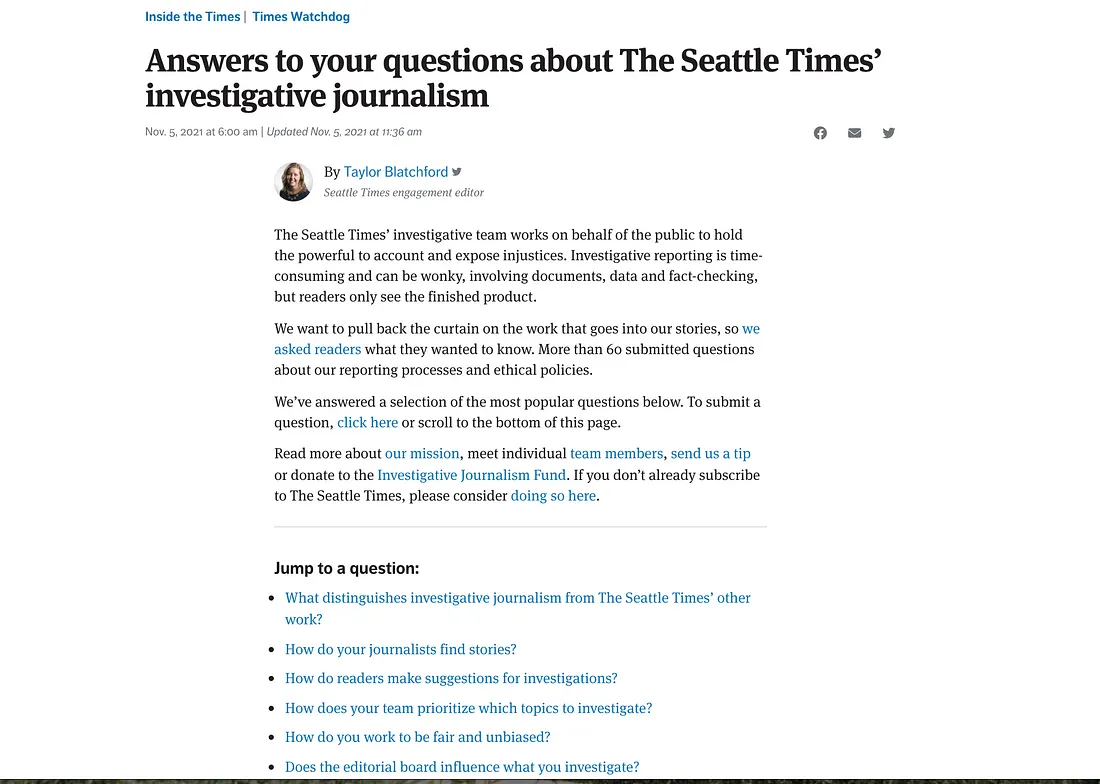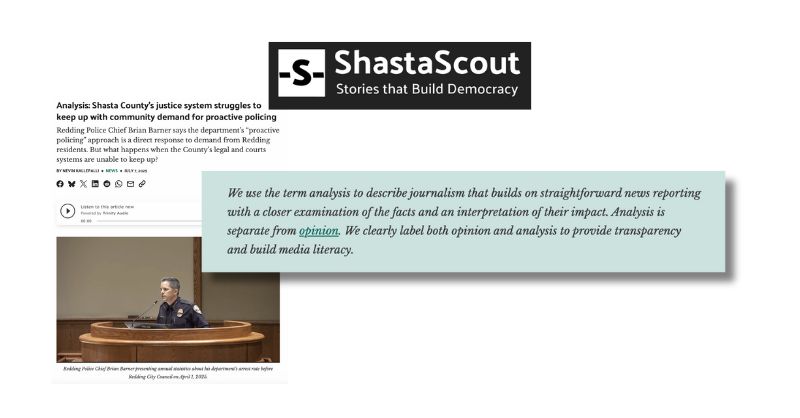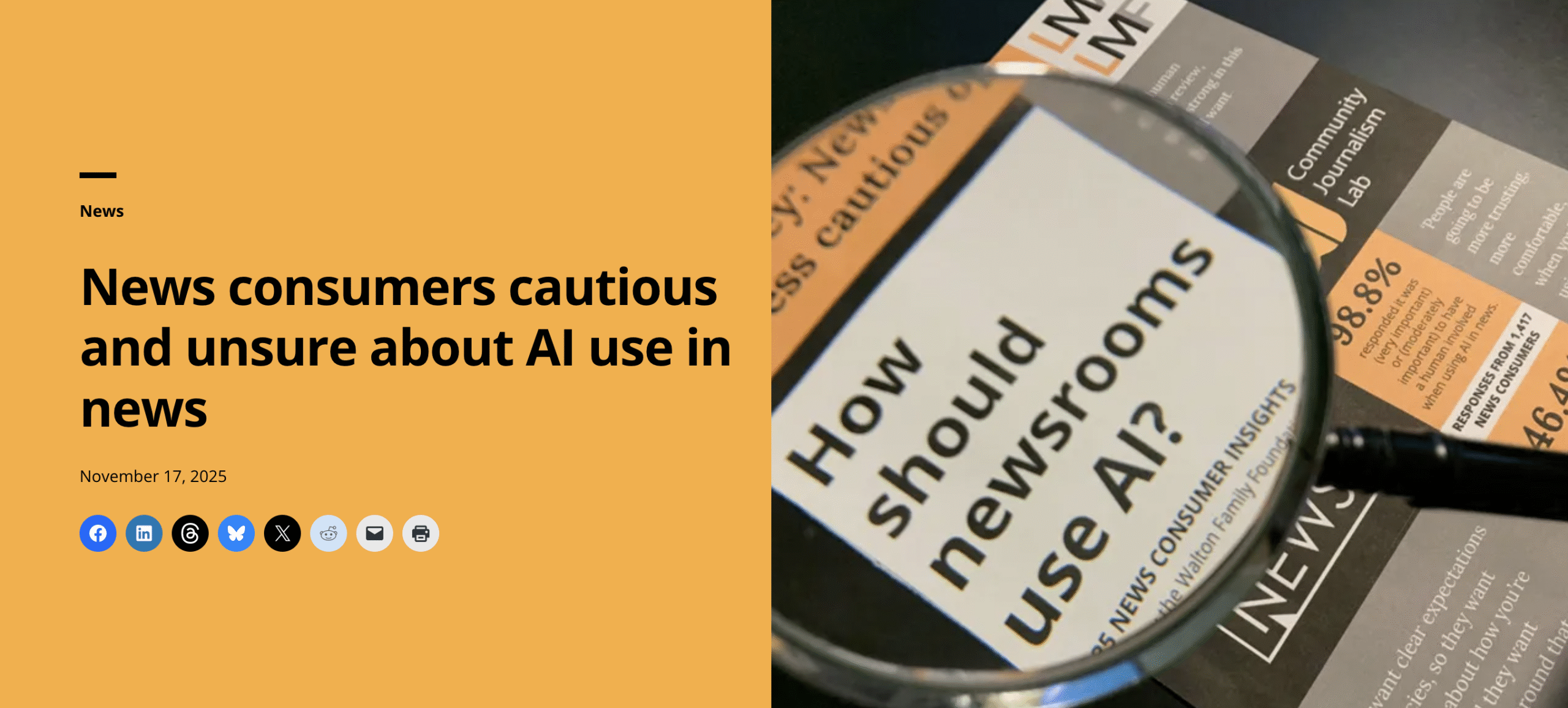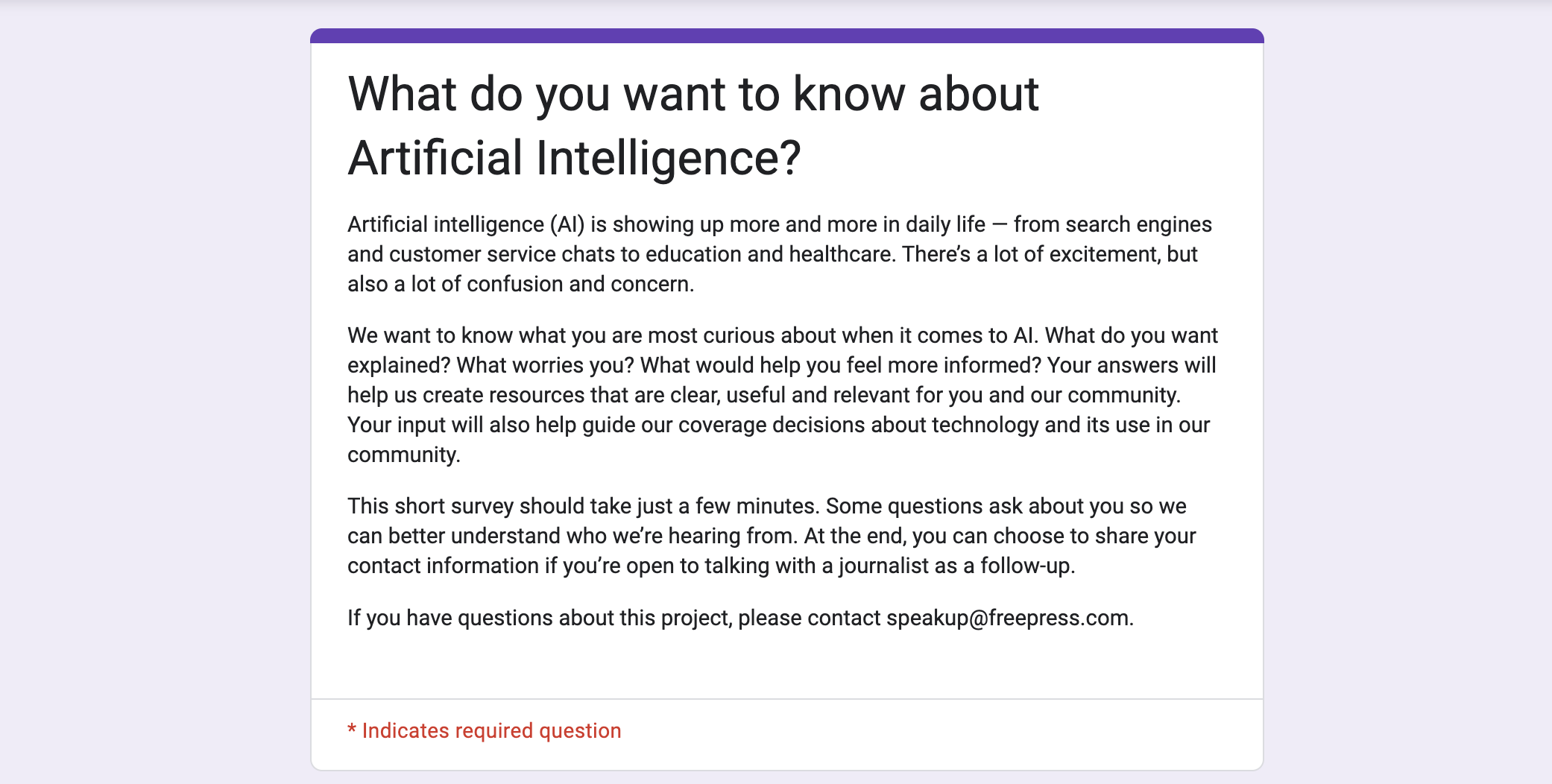
We know from user research that news consumers value depth. We also know that people say they want to see evidence of fair reporting and thoughtful decision-making.
How one investigative news team explained their goals, mission and reporting process
We know from user research that news consumers value depth. We also know that people say they want to see evidence of fair reporting and thoughtful decision-making.
That means that if you produce investigative journalism, your goal with every story is most likely aligned with what news consumers say they want. But do they recognize it? If you don’t explain how you dig deeper and fact check, people will not automatically give you credit for doing this work. Likewise for your process: Users likely don’t know how you work to be fair, how you decide which stories to pursue and how thoughtfully you consider the data you use and the sources you include.
In investigative journalism, it’s common for journalists to produce a “behind the story” piece to accompany long, investigative projects. We’ve also seen journalists use “trust nuggets” throughout a story where they explain elements of reporting like what type of data was used or why they chose to name or not name sources. Those are great practices.
But what if you explained some elements of your work in a way that transcends specific projects? How about collecting some of the basic questions people have about investigative journalism and linking the explanations in one place?
A case study: The Seattle Times
Taylor Blatchford, the engagement editor for The Seattle Times’ investigative team, worked with Trusting News to do this. She and her team created an FAQ explaining the goals, mission and reporting process of the team.
In the FAQ they answered the following questions. (Notice that each question is its own link, which makes it easy to insert the answer into emails, comment threads, social posts, and anywhere else that information about how they operate would be useful.)
- What distinguishes investigative journalism from The Seattle Times’ other work?
- How do your journalists find stories?
- How do readers make suggestions for investigations?
- How does your team prioritize which topics to investigate?
- How do you work to be fair and unbiased?
- Does the editorial board influence what you investigate?
- When you’re trying to track down the truth or falsity of something, how do you verify information and know your story is solid?
- When do you use anonymous sources and how do you vet their accounts?
- How does your mostly white investigative team authentically report on issues impacting communities of color?
- How can people support this journalism?
One of my favorite explanations is the explanation around whether the editorial board influences the team and what they can investigate. The question of influence from the opinion side of the news organization is a common one journalists have to explain. Having this explanation written and readily available allows journalists to quickly share it on social media, emails and in story comments.

One of my other favorite explanations is related to the diversity of the team and its reporting.

Their crowdsourced approach
Something else that makes this FAQ impressive is how the journalists decided what questions to answer. Taylor and her team asked their readers what they wanted to know. The journalists created a list with the responses, grouped them by topic and then answered the questions.
There really is not a better way to answer questions about your work than by asking your audience what questions they have.
Another great element about answering these questions in an FAQ format on its own page is that you can keep adding to it and can change explanations as necessary.
Taylor involved the entire investigative team in putting this FAQ together. Individual team members were assigned questions to answer, and their names were attached to the explanations when the FAQ was published. This is a great transparency element, so users can see exactly who the explanation is coming from. It’s not just The Seattle Times talking — it is an individual reporter. Adding an individual name like this helps journalists seem human and more approachable and can encourage users to submit tips or otherwise build connections to your journalists.
In addition to publishing this on their website, The Seattle Times shared it on Twitter and as an Instagram story and highlight. In both cases, they created social cards that included brief explanations for some of the questions from the FAQ.

According to Taylor, more than 2,000 readers have read the FAQ since it was published in November. She said it also has influenced multiple readers to subscribe to The Seattle Times, one of the key metrics they track with their analytics system.
A Q&A with Taylor Blatchford, the journalist behind the work
Read the comments from Taylor below to learn more about the process she used to create the FAQ, how her team is using it and what the response from the community and newsroom has been.
And in case you need a little more inspiration or a nudge to get started on something similar, Taylor said:
“You don’t necessarily need to start the process with a form or a formal survey. Think about the common comments or misconceptions you hear about your journalism.”
Trusting News would like to thank Taylor and her team for their time, effort and dedication to building trust with their community through transparency and engagement strategies like this FAQ. Through this work, we are able to learn more about what works best to build trust with the public. Without their willingness to experiment, we would not be able to share what works best for building trust with the journalism community. If you are experimenting with building trust, let us know here.

What issue related to trust were you trying to solve? What were you hoping users learned or understood better by consuming this content?
Investigative stories take a lot of time and resources. Our reporters often spend months just sifting through documents and data to figure out if a story is newsworthy and worth pursuing. With this FAQ, our team hoped to better explain to readers how we do investigative journalism and how we prioritize topics — just generally bringing transparency to our work.
There are also practices in investigative journalism that routinely draw questions from readers, like the use of anonymous sources and the verification of information. We hoped that writing out a concrete explanation of some team practices and guidelines would help us have language that we could pull from or embed in future stories, too.
How would you describe the effectiveness of the content and strategy? Did you think it was effective? Ineffective?
I was amazed by how many questions we got from readers when we published the initial callout. It ended up being more than 60, and only a few were snarky (but even those helped us identify themes that readers wanted to know more about). The analytics show that readers were interested in following up and reading more when the FAQ was published, too.
I think this strategy is effective because it created an evergreen resource that we can continue pointing to in the future. We mention a few specific stories or topics in the responses, but overall, it’s a living resource that can be adjusted or adapted as needed.
Describe what it was like to produce this content. Did it come easy to you? Was it challenging? Did it make you think differently?
The overall process was pretty straightforward, but it certainly made me think differently about how we explain our work to the public. The most challenging thing was making sure we were writing for a general audience without using terms they might not understand. When I was writing my responses and editing others, I thought, would my parents (who aren’t journalists) understand these explanations? Would my non-journalist friends? Having a hypothetical reader in mind helped me make sure our writing was approachable and not relying on journalism lingo that would leave a reader with more questions.
Can you describe how long producing this content took? Did you involve other members of your newsroom? If so, can you describe what that process looked like and how long it took?
The total process took about three months, partially because the work had to be done in between story production cycles. I wanted to give our audience sufficient time to see the call for questions and submit their own.
After we had plenty of questions from readers (more than 60), I spent some time grouping them into themes and prioritizing the issues that readers were most curious about. Our investigations editor, Jonathan Martin, and I narrowed the top questions down into a list of 10. We then decided who could best answer each of the questions and assigned some of them to reporters on our team. Lynn helped me write a few key points for each question that could guide reporters while they wrote answers.
I was pleasantly surprised by how cohesive the draft felt, even though eight different people contributed. The FAQ went through multiple rounds of editing before we finally published it.
After publishing, I made sure to send the finished FAQ to everyone who’d initially sent us a question. We promoted it on social media and have embedded it in investigative stories. Our marketing team also turned it into a series of house ads to run in the print newspaper.
Would you use this trust-building strategy or content again? If so, would you do anything differently?
Yes! I’m hoping to keep expanding the FAQ with new topics if readers submit more questions.
How would you rate the difficulty of producing this content?
Medium — it took some time, and the whole team had to be on board, but it was doable overall.
How would you describe the user response to this content? If there are specific comments you would like to share, please share a link to the comment, screenshot, quote, etc.
After sending the published FAQ out to readers who had submitted questions, I got some appreciative notes back. In the post’s comments and on social media, some people still responded with accusations of bias, which is to be expected. I know there are people who are still skeptical of our work, but I hope continuing to be transparent will help earn their trust over time.
How would you describe the response from your newsroom after publishing this content? Were people excited to work on this or see the content publish? Were people skeptical? Was it hard to convince people this was necessary?
It wasn’t hard to convince our team that this was necessary, especially because our editor fully supported the project. Reporters are busy, but they all recognized why it was important and took the time to write out a response to their designated question.
Other teams around the newsroom were interested after this was published, and I’ve talked with some of my colleagues about how we carried out the process.
At Trusting News, we learn how people decide what news to trust and turn that knowledge into actionable strategies for journalists. We train and empower journalists to take responsibility for demonstrating credibility and actively earning trust through transparency and engagement. Subscribe to our Trust Tips newsletter. Follow us on Twitter and LinkedIn. Read more about our work at TrustingNews.org.

Assistant director Lynn Walsh (she/her) is an Emmy award-winning journalist who has worked in investigative journalism at the national level and locally in California, Ohio, Texas and Florida. She is the former Ethics Chair for the Society of Professional Journalists and a past national president for the organization. Based in San Diego, Lynn is also an adjunct professor and freelance journalist. She can be reached at lynn@TrustingNews.org and on Twitter @lwalsh.



